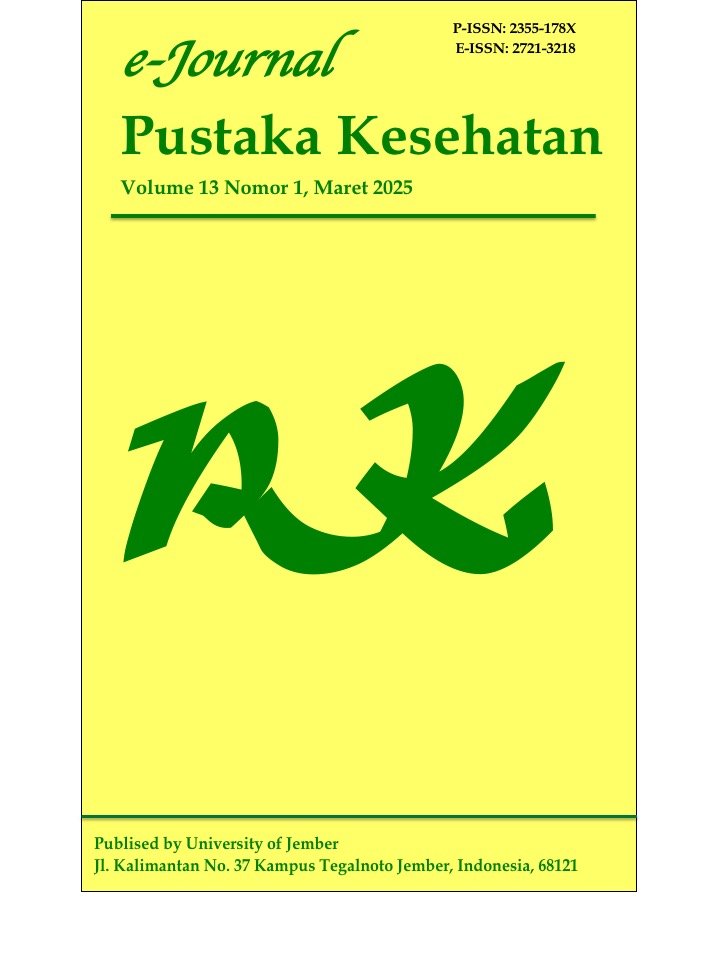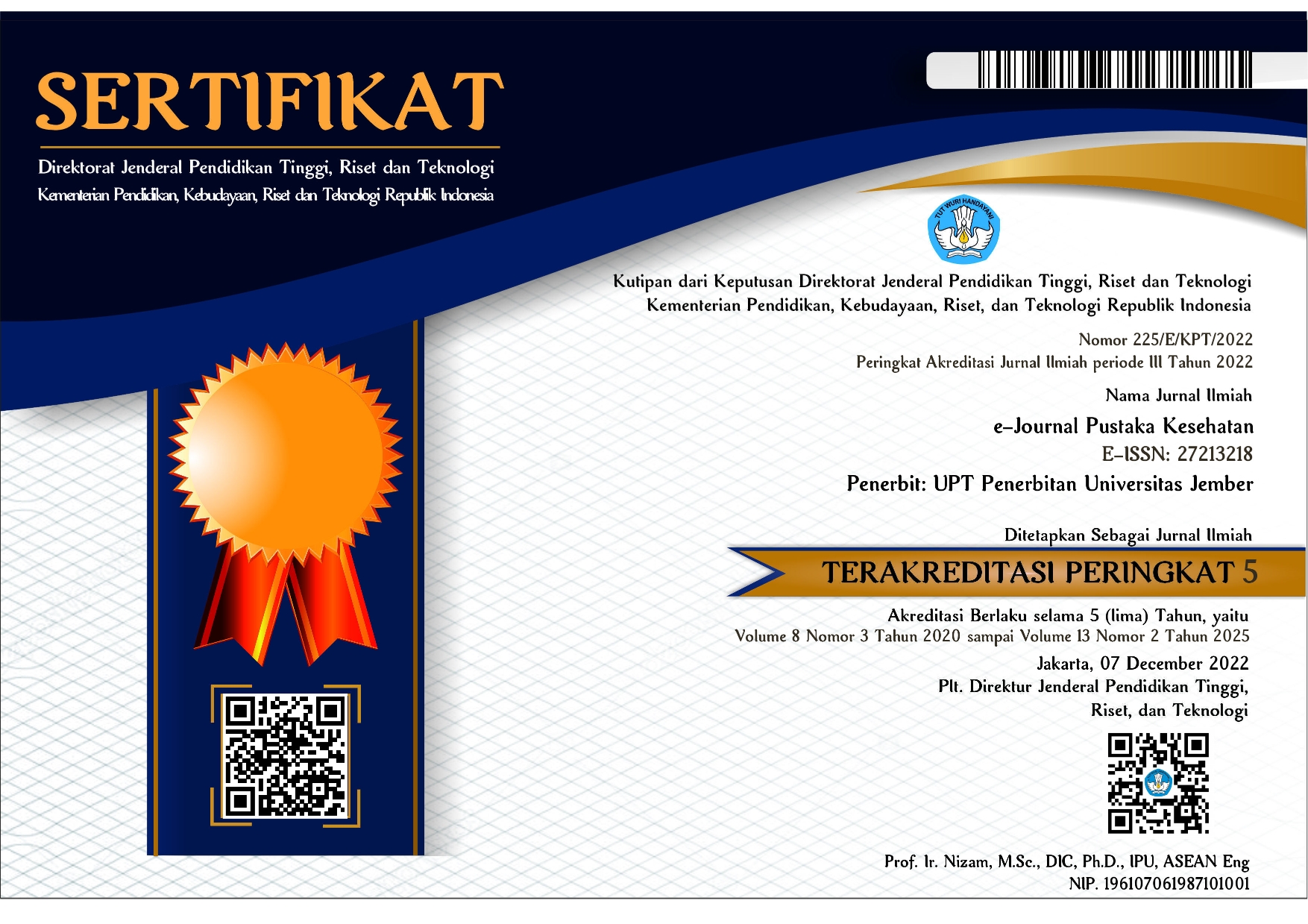Gambaran Perilaku Menggosok Gigi di Malam Hari pada Anak Usia 3-5 Tahun di Dusun Jegu, Sidoarjo
Keywords:
behavior, child, tooth brushingAbstract
Oral health is a key indicator for overall health, well-being, and quality of life. Globally, there are 2.5 billion people affected by dental caries in their permanent teeth, and more than 530 million children get dental caries in their milk teeth. In 2013, 10.4% of children aged 1-4 years had problems with their oral health. In East Java, as many as 28.6% of people suffer from this disease. One of the factors that can cause dental caries is nighttime tooth brushing behavior. In general, nighttime tooth brushing behavior is very rarely done by Indonesians. In East Java, there were 28.6% of children aged 3-5 years who had teeth and mouth problems, while in children aged 3-5 years, the tooth brushing behavior was only 23.3%. The aim of this study was to describe the nighttime tooth brushing behavior in children aged 3-5 years in Kramat Jegu, Taman, Sidoarjo. This study used descriptive analysis with a total sample of 108 children. The study found that most respondents (54 respondents or 50%) are 4-year-old children, and 107 (99.1%) of children had good nighttime tooth brushing, and only 1 (0,9%) child had bad behavior. This condition was obtained when the respondent had a questionnaire score of >15.5 for good behavior and <15.5. for poor behavior. It can be concluded that the majority of children have good nighttime tooth brushing behavior.
Downloads
References
[1] WHO. Oral Health. 2019 https://www.who.int/health-topics/oral-health/#tab=tab_1
[2] WHO. Oral Health. 2020 https://www.who.int/news-room/fact-sheets/detail/oral-health
[3] Kementrian Kesehatan Republik Indonesia. Situasi Kesehatan Gigi Dan Mulut. Pusat Data Dan Informasi Kementrian Kesehatan RI. 2014
[4] Kementrian Kesehatan Republik Indonesia. Potret Sehat Indonesia Dari Riskesdas 2018. 2018. https://www.kemkes.go.id/article/print/18110200003/potret-sehat-indonesia-dari-riskesdas-2018.html
[5] Saringingsih EMerawat Gigi Anak Sejak Usia Dini. 2014. Jakarta: Gramedia.
[6] Ramadhan. Serba-serbi Kesehatan Gigi Dan Mulut. 2010. Jakarta: Bukune.
[7] Departemen Kesehatan Republik Indonesia. Laporan Hasil Riset Kesehatan (Riskesdas) Nasional 2013. Jakarta: Kementrian Kesehatan RI. 2013
[8] Kementrian Kesehatan Republik Indonesia. Pentingnya Rutin Membawa Balita Ke Posyandu Untuk Menjaga Tumbuh Kembangnya. 2019. https://promkes.kemkes.go.id/pentingnya-rutin-membawa-balita-ke-posyandu-untuk-menjaga-tumbuh-kembangnya
[9] Hockenberry MJ, Wilson D, Rodgers CC. Wong’s Essential of Pediatric Nursing. 2021. Elsevier Health Science.
[10] Arianto A, Shalihiyah Z, Nugraha J. Perilaku Menggosok Gigi Pasd Siswa Sekolah Dasar Kelas V dan VI Di Kecamatan Sumberejo. Jurnal Promosi Kesehatan Indonesia. 2014;9(2): 127-135.
[11] Hollins C. Leviso’s Textbook for Dental Nurse. 2008. Oxford : Willey-Blackwell.
[12] Hockenberry M, Wilson D. Wong’s Nursing Care of Infants and Children. 2007. St. Louis: Mosby Elsevier.
[13] Husna, Peranan Orang Tua Dan Perilaku Anak Dalam Menyikat Gigi Dengan Kejadian Karies Anak. Jurnal Vokasi Kesehatan. 2016; 2:17 -23.
Downloads
Published
Issue
Section
License
Copyright (c) 2025 Lantin Sulistyorini, Meta Nuraini Arinda, Peni Perdani Juliningrum

This work is licensed under a Creative Commons Attribution-ShareAlike 4.0 International License.
e-Journal Pustaka Kesehatan has CC-BY-SA or an equivalent license as the optimal license for the publication, distribution, use, and reuse of scholarly work. Authors who publish with this journal retain copyright and grant the journal right of first publication with the work simultaneously licensed under a Creative Commons Attribution-ShareAlike 4.0 International License that allows others to share the work with an acknowledgment of the work's authorship and initial publication in this journal.







